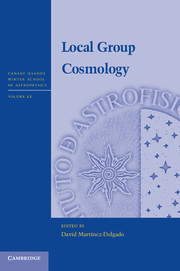Refine listing
Actions for selected content:
16950 results
5 - The Violent Universe
-
- Book:
- Revealing the Heart of the Galaxy
- Published online:
- 05 December 2013
- Print publication:
- 25 November 2013, pp 51-68
-
- Chapter
- Export citation
Frontmatter
-
- Book:
- Observational Molecular Astronomy
- Published online:
- 05 December 2013
- Print publication:
- 25 November 2013, pp i-vi
-
- Chapter
- Export citation
Contents
-
- Book:
- Revealing the Heart of the Galaxy
- Published online:
- 05 December 2013
- Print publication:
- 25 November 2013, pp v-viii
-
- Chapter
- Export citation
11 - Black Holes Here, Black Holes There…
-
- Book:
- Revealing the Heart of the Galaxy
- Published online:
- 05 December 2013
- Print publication:
- 25 November 2013, pp 149-164
-
- Chapter
- Export citation
3 - Astrochemical Processes
-
- Book:
- Observational Molecular Astronomy
- Published online:
- 05 December 2013
- Print publication:
- 25 November 2013, pp 24-49
-
- Chapter
- Export citation
1 - Introduction
-
- Book:
- Observational Molecular Astronomy
- Published online:
- 05 December 2013
- Print publication:
- 25 November 2013, pp 1-15
-
- Chapter
-
- You have access
- Export citation
Acknowledgements
-
- Book:
- Revealing the Heart of the Galaxy
- Published online:
- 05 December 2013
- Print publication:
- 25 November 2013, pp ix-x
-
- Chapter
- Export citation
2 - The Discovery of the Milky Way Galaxy
-
- Book:
- Revealing the Heart of the Galaxy
- Published online:
- 05 December 2013
- Print publication:
- 25 November 2013, pp 13-24
-
- Chapter
- Export citation

Local Group Cosmology
-
- Published online:
- 05 November 2013
- Print publication:
- 21 October 2013
6 - Tutorial: The analysis of colour-magnitude diagrams
-
-
- Book:
- Local Group Cosmology
- Published online:
- 05 November 2013
- Print publication:
- 21 October 2013, pp 192-225
-
- Chapter
- Export citation
4 - The Milky Way satellite galaxies as critical tests of contemporary cosmological theory
-
-
- Book:
- Local Group Cosmology
- Published online:
- 05 November 2013
- Print publication:
- 21 October 2013, pp 123-161
-
- Chapter
- Export citation
Frontmatter
-
- Book:
- Local Group Cosmology
- Published online:
- 05 November 2013
- Print publication:
- 21 October 2013, pp i-vi
-
- Chapter
- Export citation
7 - Tutorial: Modeling tidal streams using N-body simulations
-
-
- Book:
- Local Group Cosmology
- Published online:
- 05 November 2013
- Print publication:
- 21 October 2013, pp 226-232
-
- Chapter
- Export citation
2 - Dark matter content and tidal effects in Local Group dwarf galaxies
-
-
- Book:
- Local Group Cosmology
- Published online:
- 05 November 2013
- Print publication:
- 21 October 2013, pp 47-94
-
- Chapter
- Export citation
Contents
-
- Book:
- Local Group Cosmology
- Published online:
- 05 November 2013
- Print publication:
- 21 October 2013, pp vii-viii
-
- Chapter
- Export citation
Acknowledgments
-
- Book:
- Local Group Cosmology
- Published online:
- 05 November 2013
- Print publication:
- 21 October 2013, pp xv-xvi
-
- Chapter
- Export citation
Preface
-
- Book:
- Local Group Cosmology
- Published online:
- 05 November 2013
- Print publication:
- 21 October 2013, pp xiii-xiv
-
- Chapter
- Export citation
List of contributors
-
- Book:
- Local Group Cosmology
- Published online:
- 05 November 2013
- Print publication:
- 21 October 2013, pp ix-x
-
- Chapter
- Export citation
Abbreviations
-
- Book:
- Local Group Cosmology
- Published online:
- 05 November 2013
- Print publication:
- 21 October 2013, pp xvii-xviii
-
- Chapter
- Export citation
5 - Stellar tidal streams
-
-
- Book:
- Local Group Cosmology
- Published online:
- 05 November 2013
- Print publication:
- 21 October 2013, pp 162-191
-
- Chapter
- Export citation
